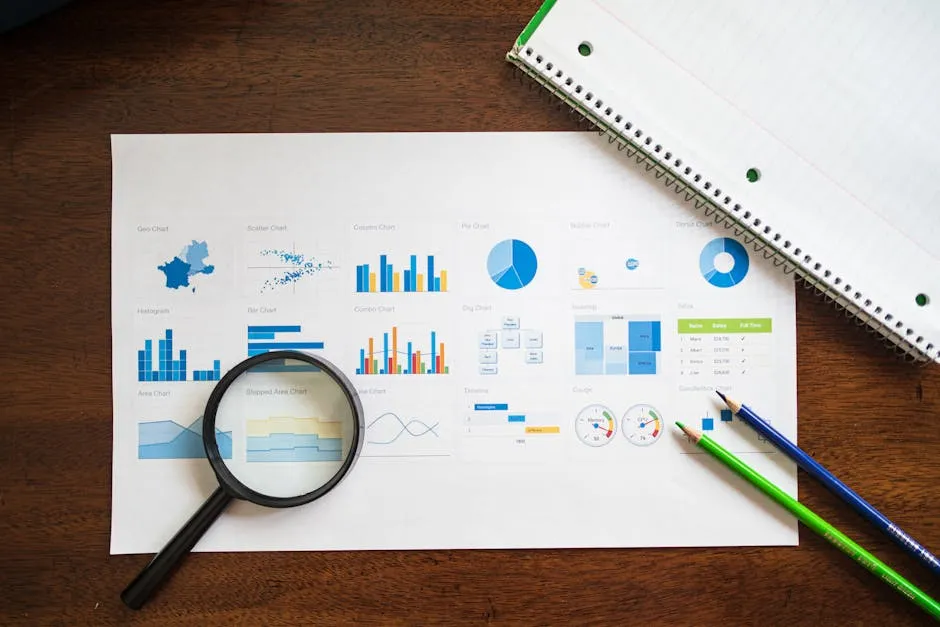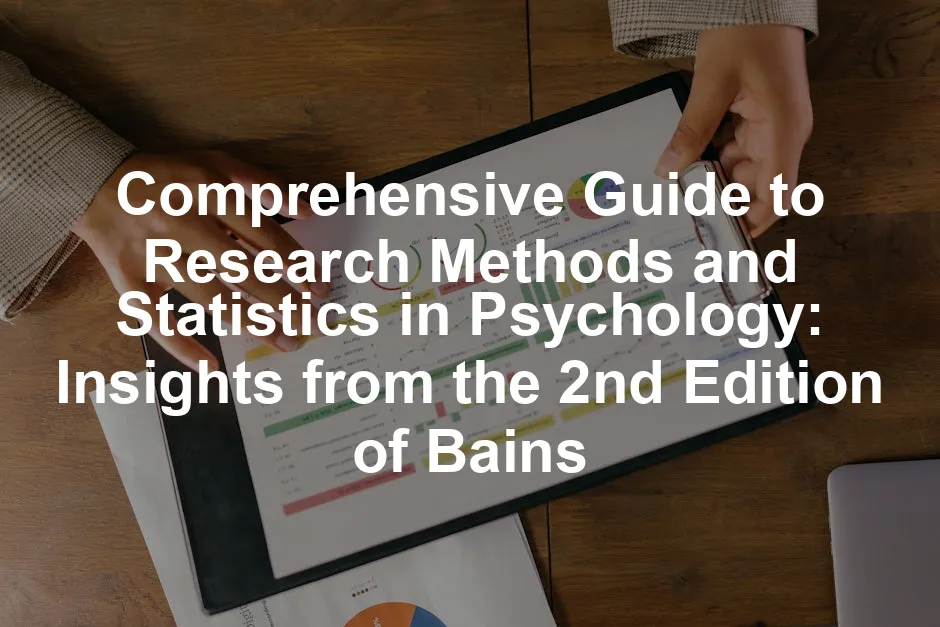Introduction
Research methods and statistics are essential in psychology. They form the backbone of our understanding of human behavior and mental processes. Without solid research, psychology would just be a collection of opinions, not a science. That’s where Bernard C. Beins and Maureen A. McCarthy’s Research Methods and Statistics in Psychology, 2nd Edition comes into play. This authoritative guide offers an accessible pathway for students to grasp complex concepts and techniques.
The importance of this edition cannot be overstated. It’s updated with fresh examples and expanded discussions on ethical considerations and diversity in research. In an era where misinformation spreads like wildfire, having a strong grasp of research methods is crucial for anyone aiming to critically evaluate psychological claims. This article aims to provide an overview of the key concepts, techniques, and ethical considerations presented in the book. Buckle up, because we’re about to embark on a scholarly adventure!

Understanding Research in Psychology
The Role of Research in Psychology
Research serves as the bedrock of psychological knowledge. It helps us understand what drives behaviors, emotions, and thoughts. By conducting studies, psychologists can uncover patterns and correlations that inform both clinical practice and public policy. For instance, research on the impact of childhood trauma has influenced mental health policies and intervention strategies.
Furthermore, research findings often lead to the development of therapeutic techniques. These techniques help people manage mental health issues effectively. Without research, we’d be left guessing about what works and what doesn’t.
If you’re keen on mastering the essentials of research methods, consider grabbing The Essentials of Research Methods in Psychology. This resource simplifies complex concepts into digestible lessons, ensuring you’re well-equipped for your research journey!

Types of Research Methods
Quantitative vs. Qualitative Research: Quantitative research focuses on numerical data. Think statistics, surveys, and experiments—it’s all about measuring and analyzing. On the other hand, qualitative research dives into the richness of human experience. It explores thoughts and feelings, often through interviews and open-ended surveys. Both methods have their merits, and they often complement each other.
Experimental Research: This method is the crown jewel of psychological research. It involves controlled studies where researchers manipulate one variable to see its effect on another. Imagine a scientist in a lab, carefully tweaking conditions to observe behavior—this is where causation is established.
Non-experimental Research: Not all research requires a lab coat. Non-experimental methods include observational studies, surveys, and case studies. These approaches are invaluable for gathering real-world data and understanding phenomena in natural settings. For example, an observational study might reveal how children interact in a playground, offering insights that experiments cannot.
In conclusion, understanding these research methods equips aspiring psychologists with the tools to analyze and interpret data effectively. It’s like having a treasure map that leads to the hidden gems of knowledge. So, let’s keep our compasses pointed toward the fascinating world of psychological research!

Statistical Techniques in Psychology
Overview of Statistics in Psychology
Statistics is the unsung hero of psychology. Without it, researchers would be like a ship lost at sea—no compass, no navigation. Statistics helps us analyze data and draw meaningful conclusions about human behavior.
In psychology, we primarily use two types of statistics: descriptive and inferential. Descriptive statistics summarize data, providing a snapshot of what’s going on. They allow researchers to present raw data in a more digestible format. Meanwhile, inferential statistics help us make predictions or generalizations about a population based on a sample. Think of it as making educated guesses while playing poker—using what you see to predict your opponents’ hands!

Key Statistical Techniques
Descriptive Statistics
Descriptive statistics are like the appetizers at a fancy buffet—they give you a taste without overwhelming you. Key measures include:
- Mean: The average score. It’s like the central character in a story, where all data points come together.
- Median: The middle score when all values are arranged. If the mean is the popular kid, the median is the quiet achiever—the one who balances out the extremes.
- Mode: The most frequently occurring score. It’s the life of the party, always showing up the most!
But wait, there’s more! Measures of variability also play a crucial role:
- Range: The difference between the highest and lowest scores. It tells you how spread out the data is, like the distance between the tallest and shortest basketball players.
- Variance: This measures how far each number in the set is from the mean. It’s the drama queen of statistics, highlighting how much the numbers can vary.
- Standard Deviation: A more digestible form of variance, representing the average distance of each data point from the mean. Think of it as the friendly neighbor who keeps everyone in check.

Inferential Statistics
Now, let’s move to inferential statistics. These tools help us understand if our findings are significant or just lucky breaks.
- Hypothesis Testing: This is where psychologists test their predictions. They start with a null hypothesis (no effect) and an alternative hypothesis (an effect exists). Through various tests, they determine which hypothesis stands strong.
- p-values: A p-value tells you the probability that your results occurred by chance. A p-value less than 0.05 is like a green light, indicating that the results are statistically significant. However, don’t get too comfortable; a low p-value doesn’t guarantee that your findings are practically meaningful!
- Confidence Intervals: These intervals provide a range of values that likely include the population parameter. They are like a safety net, offering a cushion around the estimate. If the interval is narrow, your estimate is precise. If it’s wide, well, perhaps your data needs a little more attention.
- Effect Sizes: This statistic measures the strength of the relationship between variables. It’s not just about whether something happened, but how substantial that effect is. A small effect size might be interesting, but a large one can rock the psychological world!

Advanced Statistical Methods
Once you’ve mastered the basics, it’s time to level up with advanced statistical methods:
- ANOVA (Analysis of Variance): This technique compares means across multiple groups. It’s like comparing the performance of different schools in a district to see which one excels in academics.
- Regression Analysis: This method examines the relationship between variables. Want to know how study time affects exam scores? Regression’s your go-to! It predicts outcomes based on the relationship between independent and dependent variables.
- Factor Analysis: This technique identifies underlying factors that explain observed correlations between variables. It’s like finding hidden patterns in your sock drawer—unraveling the mess to see the organization beneath.
- Non-parametric Tests: These tests are useful when data doesn’t meet the assumptions required for parametric tests. Think of them as the flexible friends of the statistical world—ready to adapt when things aren’t perfect.
In summary, statistics is the backbone of psychological research. From basic descriptive stats to advanced techniques, they help us interpret the complexities of human behavior. Understanding these statistical tools not only enhances research but also strengthens our ability to make informed decisions in psychology.

Statistical Software in Psychology Research
In the realm of psychology research, statistical software is a must-have. It’s like having a trusty sidekick; without it, analyzing data would feel like trying to make a soufflé without an oven. Here are some of the most popular tools that researchers rely on:
- SPSS (Statistical Package for the Social Sciences): Ah, SPSS. The go-to for many in psychology. It’s user-friendly and perfect for those who prefer a graphical interface. With its menu-driven approach, you can perform complex analyses without needing to write endless code. It’s also packed with features for data manipulation and statistical testing. Get your hands on SPSS Statistics Software to make your analysis a breeze!
- R: For those who love flexibility, R is the way to go. It’s an open-source programming language that offers a plethora of packages for statistical analysis. While it has a steeper learning curve than SPSS, R’s capabilities are vast. If you want to create stunning visualizations and conduct advanced analyses, R Programming Language Book is your best friend.
- Python: In recent years, Python has gained traction in the research community. It’s not just for programmers anymore! With libraries like pandas, NumPy, and SciPy, you can handle data analysis with ease and efficiency. Plus, the integration of machine learning makes Python a powerful tool for those looking to dive into predictive analytics. You can start your journey with Python for Data Analysis by Wes McKinney.
These software tools are essential gears in the machinery of psychological research, helping researchers analyze data, interpret results, and draw meaningful conclusions. With the right software at your fingertips, the world of statistics becomes a bit less daunting and a lot more exciting!

Ethical Considerations in Psychological Research
Importance of Ethics in Research
Ethics in psychological research is not just a checkbox; it’s the foundation of trust. Whether you’re studying the effects of therapy or the impact of social media, ethical considerations are crucial. They protect participants, enhance the credibility of research, and ensure that findings can be trusted and applied in real-world contexts.
Imagine a world where researchers could act without ethical oversight. Scary, right? Unchecked studies could lead to harmful practices or misinterpretations. That’s why ethical guidelines exist—to safeguard both the subjects and the integrity of the research.

Key Ethical Principles
- Informed Consent: Participants must know what they’re signing up for. This includes the study’s purpose, procedures, and any potential risks. It’s like giving someone the menu before they order dinner; they need to know what they’re getting into!
- Confidentiality: Protecting participants’ identities is paramount. Researchers must ensure that personal data is kept secure and private. This principle builds trust and encourages open participation. After all, nobody wants their sensitive info splashed across the headlines!
- Right to Withdraw: Participants should feel free to leave a study at any time without penalty. It’s essential for maintaining autonomy. No one should feel trapped in an experiment, like a hamster in a wheel!
- Institutional Review Boards (IRBs): These boards oversee research proposals to ensure ethical standards are met. Think of them as the guardians of research ethics. They review studies, assess risks, and protect participants’ rights. Researchers must submit their plans to IRBs before commencing any study. Without their approval, research cannot proceed.

Addressing Ethical Dilemmas
Even with guidelines, ethical dilemmas can arise. For instance, consider a study that involves vulnerable populations, like children or individuals with mental health issues. Balancing the need for data with the potential for harm can be tricky.
One common dilemma involves deception. Sometimes, researchers use deception to ensure unbiased results. However, this can create distrust. To address such dilemmas, researchers should prioritize transparency wherever possible and debrief participants after the study to explain any deception.
Another example is the handling of sensitive topics. Researchers must tread lightly when exploring subjects like trauma or abuse. Providing support and resources after participation can help mitigate harm.
In summary, navigating ethical considerations in psychological research is essential. By adhering to key principles and addressing dilemmas thoughtfully, researchers can uphold the integrity of their work while protecting participants. A solid ethical framework not only enhances research credibility but also fosters trust within the community.

Diversity and Inclusion in Psychological Research
Importance of Diversity in Research
Diversity is more than a buzzword; it’s crucial for meaningful research in psychology. When we include varied perspectives, we enhance the validity of our findings. Imagine trying to understand human behavior through a narrow lens—it’s like watching a movie with one eye closed! A diverse research pool captures the richness of human experiences, leading to more applicable and relatable outcomes.
For instance, studies that include participants from different cultural backgrounds can reveal unique insights into behavioral patterns. These insights can challenge existing theories and expand our understanding of psychological phenomena. In short, diversity strengthens the research foundation, making it relevant to a broader audience.

Strategies for Inclusive Research
To achieve inclusivity, representation in research samples is key. Researchers must actively seek participants from various demographics—age, gender, ethnicity, and socioeconomic status. This approach ensures that research findings reflect the complexity of human experience.
Moreover, cultural competence in research design is essential. Researchers must be aware of cultural differences that could influence study outcomes. This means recognizing biases, understanding cultural contexts, and adapting methods accordingly. For example, using culturally relevant language in surveys can make participants feel more comfortable, leading to more honest responses.
By prioritizing representation and cultural awareness, researchers can create a more inclusive research environment. This not only enriches the study but also fosters trust among diverse communities, paving the way for impactful psychological research.

Real-World Applications of Research Methods and Statistics
Case Studies from the 2nd Edition of Bains
The second edition of Research Methods and Statistics in Psychology by Bernard C. Beins and Maureen A. McCarthy is packed with illuminating case studies. One noteworthy example explores the impact of therapy on anxiety levels among adolescents. The researchers employed a mixed-methods approach, combining qualitative interviews with quantitative surveys. This dual strategy provided a comprehensive view of how therapy affected not just symptoms but also overall well-being.
Another case study examined the effects of social media on self-esteem. Researchers conducted longitudinal studies to track changes in self-esteem over time, correlating them with social media usage patterns. The findings revealed that increased social media engagement could lead to lower self-esteem, especially among younger users. This real-world application of research methods highlights the power of empirical data in addressing contemporary issues.

Impact on Policy and Practice
Research findings play a pivotal role in shaping psychological practice and policy decisions. For instance, studies demonstrating the effectiveness of cognitive-behavioral therapy in treating depression have influenced treatment protocols worldwide. Policymakers rely on empirical data to allocate funding for mental health programs that address pressing community needs.
Moreover, research can also inform public policy. For example, findings regarding the impact of childhood trauma on long-term mental health have led to changes in educational and social services. Policymakers are increasingly recognizing the need for trauma-informed approaches in schools and communities, ultimately improving support for affected individuals.
In summary, research methods and statistics in psychology not only advance our understanding of mental health but also drive meaningful change in practices and policies. By utilizing robust research, we can create a more supportive environment for individuals facing psychological challenges.

FAQs
What are the main differences between quantitative and qualitative research in psychology?
Quantitative research focuses on numerical data, using statistics to analyze patterns and relationships. It often involves structured methods like surveys and experiments. Qualitative research, on the other hand, explores the richness of human experience. It utilizes open-ended questions and interviews to gather insights about thoughts and feelings, often leading to a deeper understanding of psychological phenomena.
Why is ethics important in psychological research?
Ethics are crucial in psychological research to ensure the safety and well-being of participants. Unethical practices can lead to harm, misinformation, and a loss of trust in the research community. Ethical guidelines, such as informed consent and confidentiality, help protect participants’ rights and ensure that studies are conducted responsibly.
How can I improve my statistical skills for psychological research?
To enhance your statistical skills, consider enrolling in online courses or workshops focused on statistics in psychology. Textbooks that cover statistical methods, like the second edition of Bains, can also be immensely helpful. Additionally, practicing with statistical software (e.g., SPSS, R) can build your confidence and competence in data analysis.
What role does diversity play in psychological research?
Diversity enriches psychological research by capturing a wide range of perspectives and experiences. Including participants from various backgrounds ensures that findings are more generalizable and applicable to different groups. It helps challenge existing theories and fosters a more inclusive understanding of human behavior.
Where can I find more information on research methods and statistics?
In addition to the second edition of Bains, numerous resources are available to deepen your understanding. Online platforms like Coursera and edX offer courses on research methods. You can also explore workshops, webinars, and academic journals dedicated to psychology and research methodologies for the latest insights and developments.
Please let us know what you think about our content by leaving a comment down below!
Thank you for reading till here 🙂
All images from Pexels




